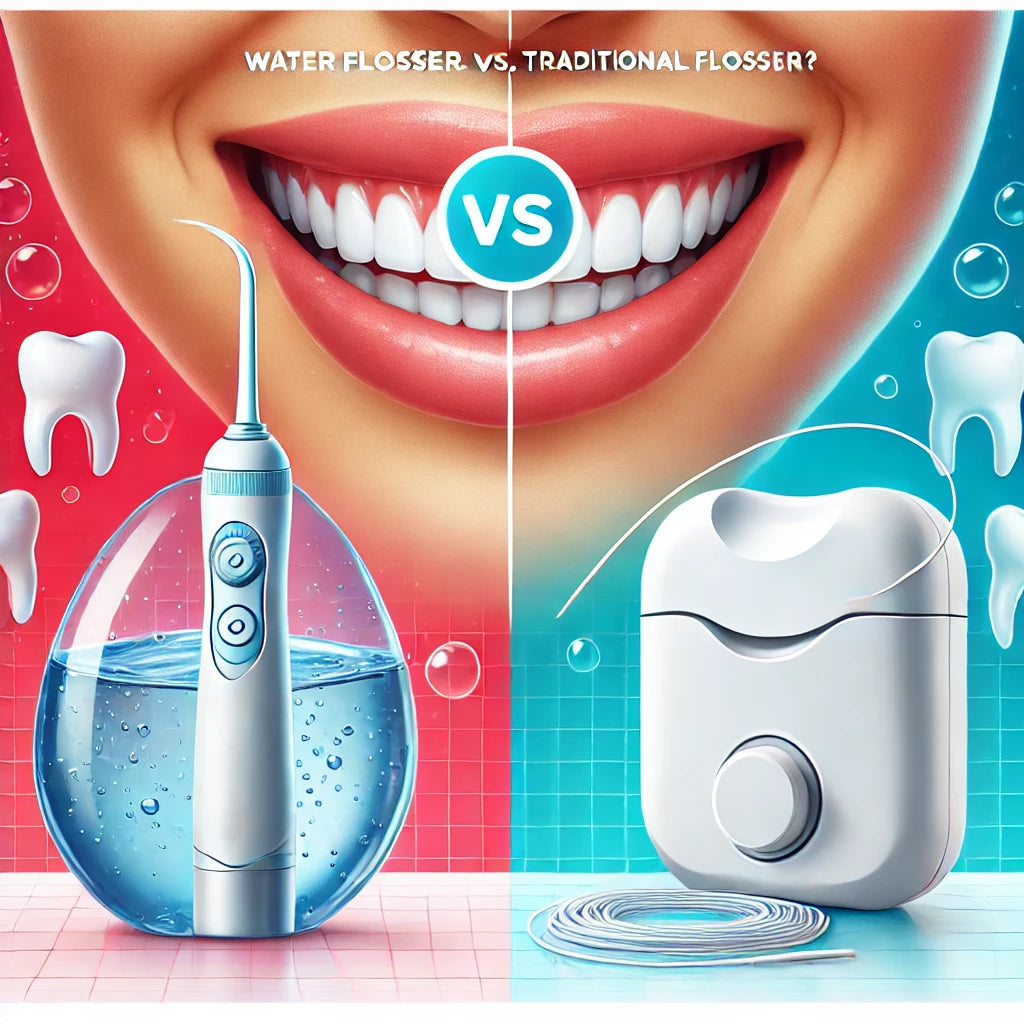Introduction: In the realm of oral hygiene, the debate between water flossers and traditional flossing methods continues to evolve. Both approaches have their merits, but understanding their unique benefits, considerations, and recommendations can help you make an informed decision for your dental care routine.
Understanding Traditional Flossing: Traditional flossing remains a cornerstone of oral hygiene, involving the use of dental floss or tape to manually clean between teeth and along the gumline. This method effectively removes plaque and food debris, contributing to healthier teeth and gums.
Benefits of Traditional Flossing:
- Effective Plaque Removal: Dental floss allows for precise cleaning between teeth where toothbrush bristles can't reach, helping to prevent cavities and gum disease.
- Affordability and Accessibility: Dental floss is widely available, affordable, and easy to use, making it accessible for daily oral care routines.
- Portability: Dental floss is compact and travel-friendly, allowing for easy maintenance of oral hygiene habits on the go.
Exploring the Benefits of Water Flossers: Water flossers, also known as oral irrigators, offer a modern alternative to traditional flossing. These devices use a pulsating stream of water to clean between teeth and below the gumline, providing several unique advantages:
- Effective Plaque Removal: Studies indicate that water flossers can reduce plaque buildup more effectively than traditional flossing alone, particularly in hard-to-reach areas (Source: American Dental Association).
- Gentle on Gums: The pulsating water stream massages gums and stimulates circulation without causing irritation, making water flossers suitable for individuals with sensitive gums or periodontal pockets.
- Accessibility: Water flossers are user-friendly and can be easier to maneuver for individuals with braces, dental implants, or limited dexterity.
Recommendations for Using Water Flossers: To maximize the benefits of a water flosser and ensure proper oral hygiene, follow these recommendations:
- Select the Right Tip: Choose a flosser tip that suits your dental needs (e.g., standard, orthodontic, or periodontal tip).
- Adjust Pressure Settings: Start with a lower pressure setting and gradually increase to a comfortable level for effective cleaning without discomfort.
- Use Warm Water: Using warm water can enhance comfort and help loosen debris more effectively.
- Follow a Pattern: Begin with the back teeth and work your way toward the front, focusing on each tooth surface and along the gumline.
- Clean the Reservoir: Regularly clean and refill the water reservoir to maintain optimal hygiene and device performance.
Comparison Chart: Traditional Flossing vs. Water Flossers
| Feature | Traditional Flossing | Water Flossers |
|---|---|---|
| Plaque Removal | Effective for removing plaque between teeth. | More effective in reducing plaque, especially in hard-to-reach areas. |
| Gum Health | Helps maintain healthy gums with proper technique. | Massages gums and improves circulation, beneficial for sensitive gums. |
| Ease of Use | Requires manual dexterity for effective use. | Easier to use, especially for those with braces or dental work. |
| Portability | Compact and travel-friendly. | Requires access to water and electricity, less portable. |
| Cost | Low-cost, readily available. | Higher initial investment, but cost-effective in the long term. |
| Effectiveness with Braces | Can be challenging to clean around orthodontic appliances. | Effective in cleaning around braces and dental implants. |
| User Preference | Personal preference plays a role in consistency and effectiveness. | Suitable for users who prefer a gentler cleaning method. |
Considerations for Different Dental Needs: Choosing between water flossers and traditional flossing methods depends on individual dental needs and preferences:
- Braces and Orthodontics: Water flossers are highly recommended for individuals with braces, as they can effectively clean around wires and brackets without risk of damage.
- Sensitive Gums: Those prone to gum sensitivity may find water flossers more comfortable and less likely to cause irritation compared to traditional flossing.
Why ToothPow’s Water Flosser is a Great Selection: When it comes to choosing a water flosser, ToothPow’s model stands out for several reasons. Here’s why it’s a top choice for maintaining your oral hygiene:

- Compact and Portable: At under 6 inches tall, ToothPow’s water flosser is perfect for travel and keeps your counter space tidy. Its convenient size makes it easy to carry with you, ensuring you can maintain your oral care routine even when you're on the go.
- Long Battery Life: With a 90-day battery life, ToothPow’s water flosser offers the convenience of wireless use and easy USB charging. You won’t have to worry about frequent recharges, making it ideal for both daily use and travel.
- Waterproof Design: The device is IPX7 waterproof, which means it can be safely used in the shower, adding an extra layer of convenience to your oral care routine.
- Versatile Cleaning Options: Featuring four speed settings and three nozzles with 360° rotation, ToothPow’s water flosser provides a comprehensive clean tailored to your dental needs.
Expert Recommendations and Conclusion: Dental professionals often recommend a combination of both methods to maximize oral hygiene benefits. Traditional flossing provides precise cleaning, while water flossers offer added convenience and effectiveness in specific situations.
Conclusion: In the debate of water flossers vs. traditional flossing, the best choice depends on your dental health needs, personal preferences, and lifestyle factors. Both methods play important roles in maintaining optimal oral hygiene when used correctly and consistently.
Call to Action: Ready to explore the benefits of water flossers or traditional flossing methods? Visit ToothPow to discover our selection of oral care products designed to support your unique dental hygiene needs. Start your journey to a healthier smile today!

